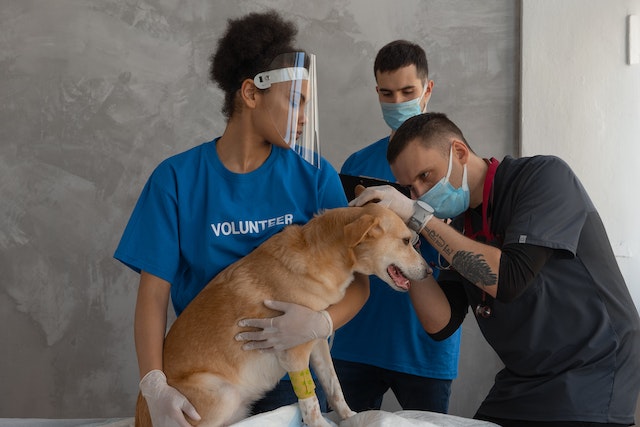20 Common Symptoms Of Worms In Dogs You Should Know

Dog owners always want to know the symptoms of worms in dogs, as a dog owner and lover with lots of experience with dogs.
I will outline all the common symptoms of worms in dogs. Some of which are my personal experience and others based on my research.
Am not a veterinarian, but what you should know is that I have had dogs for over 16 years.
So I have had so many experiences with symptoms of worms in dogs over the years.
What are worms found in dogs?
Worms are tiny parasites that are found in the majority of dog’s intestines or bodies. Roundworms, tapeworms, hookworms, whipworms, and heartworms are the five major kinds of worms that infect domestic dogs.
Dogs can carry a number of worms, but some are more common than others. One of the most common worms in dogs is roundworms.
This worm is a parasite that occupies the intestines and can cause a host of symptoms.
Roundworm infestation is often asymptomatic, but it can be accompanied by vomiting, diarrhea, weight loss, and abdominal pain.
In order to be sure your dog does not have this type of worm infestation, it’s important to take them to the vet for a fecal test.
Symptoms Of Worms In Dogs
When a dog has worms, it’s typically going to have one or several symptoms. These can range from diarrhea and vomiting to lethargy and appetite loss.
Some worms, in particular roundworms in puppies, can cause a potbelly with a thin spine.
Worms in your pup can be a serious problem that needs immediate treatment, so it’s important to know the signs of worm infestation.
Here are some common symptoms of worms in dogs:
The presence of worms in the vomit of dogs
It’s fairly uncommon to find worms in your dog’s vomit if they’re ill.
Worms in your dog’s vomit are one of the most telltale indicators that he’s unwell.
However, not all parasites are visible to the naked eye.
As a result, there are several trends that you may not notice when the worms are in the larval stage.
Presence of swollen or distended belly
In severe cases, a swollen/distended stomach (pot-belly) can be seen in puppies.
The most frequent form of worm that causes this symptom is roundworms.
Puppies who have taken up worms from their mother generally have a potbellied look.
Worms are transmitted either before birth through the placenta or after birth while breastfeeding.
Presence of mucus or blood in dog’s feces
The presence of mucus, blood, or worm segments in your dog’s feces is a major indicator of worm presence.
The intestines produce mucus as a defense against parasite invasion, which makes your dog’s feces sticky.
Roundworms and tapeworm segments can break off and end up in your dog’s feces.
Continuous and persistent vomiting
The dog will vomit if the worms go into his stomach. If your dog eats something that has been infected with worms, they may vomit the meal.
If this happens, make sure your dog drinks at least 1/2 cup of water every hour.
It’s also critical to encourage your dog to drink often and to give it big amounts of water so that the worm is expelled from the system and does not remain in the GI tract.
Take into account, however, that other health problems, such as indigestion, can cause vomiting.
If your dog starts vomiting often, get medical attention right once.
Even if your dog doesn’t have worms, vomiting might indicate a different health issue.
Changes in the dog’s coat or hair that are visible
Hair and skin are the first to suffer if your dog is malnourished.
If your cat is afflicted with worms, its hair may seem dull, rumpled, or clumped due to a lack of nutrients or dehydration.
Keep an eye out for itching and a dull coat, especially around your dog’s hindquarters.
You should contact a veterinarian if you detect any strange or abrupt changes in your dog’s fur or hair.
Continuous and persistent diarrhea
Worms in dogs are most commonly manifested by this symptom.
Symptoms will come and go, but diarrhea will persist around 3-5 days on average.
When the worms travel through the intestines and into the colon, they are said to be at this stage.
Blood may be seen in the feces of dogs with hookworms.
When an infection progresses, bloody diarrhea occurs, which can lead to chronic bloody diarrhea if not addressed.
Worms can cause soft stools and diarrhea in your dog.
Prolonged diarrhea can cause dehydration, which is why it’s critical to see a veterinarian very once.
The dog will show signs of breathing problems
Worms not only affect a dog’s internal system, but they may also create a loss of energy, making the dog feeble.
Heartworms are among the most deadly of all worms, and they have been linked to respiratory difficulties.
The good news is that heartworm is transmitted to dogs exclusively through mosquito bites, which can be prevented.
The presence of worms in the buttocks of dogs
As segments of the tapeworm break off and travel into the dog’s stool, they may be seen crawling on the surface of the feces.
Worm proglottid segments resemble cooked white rice grains or cucumber seeds in appearance.
Worm segments that go around the dog’s anus are rare most times but can still be seen.
Presence of worms in dogs feces
You’ll most likely see worms in your dog’s feces if it has them.
Some parasites will be discharged during a bowel movement if they have built up in your dog’s intestines.
The most prevalent sign of worms in dogs is the presence of worms in their stool.
This symptom appears when the worms have matured and are ready to destroy the contents of the dog’s system.
Sudden and continuous weight loss
Weight loss and decreased growth are symptoms of a parasitic infection, such as worms.
If your dog isn’t growing as expected or suddenly loses weight, it’s essential to have him checked for worms.
Parasites will impede your dog’s ability to absorb nutrients from its meal, resulting in weight loss.
Bloating
In pups that have been infected with worms, bloating is a common symptom.
Bloating is more common in nursing kittens who have been exposed to parasites like worms through their mother.
They were exposed to the worms through their mother, either from drinking the mother’s breast milk or by coming into contact with the worms in the mother’s womb.
Persistent coughing
Coughing is one of the most prevalent worm symptoms in dogs.
Coughing is a symptom of heartworms, although it can also be caused by hookworms or roundworms.
In contrast to a normal cough, which is forceful and rare, dogs with heartworms have a dry and chronic cough.
Your dog may cough after exercising if he has heartworms in the early stages.
This is due to the heartworm parasites moving into the lungs, obstructing oxygenated blood flow.
Visible changes in the color of dog feces
Some worms produce visible changes in a dog’s feces color, as well as blood color changes and irregular bowel movements.
Dark, tarry stool indicates the presence of blood, possibly from hookworms.
Worms in the dog’s stomach can also cause diarrhea.
Scooting
Despite anal gland, issues are frequently the cause of scooting.
Dogs with worms will occasionally rub their bottom on the floor to relieve themselves of the itch produced by the worms in the anal region.
Your dog may also bite or lick his bottom to ease the irritation caused by the worms.
Sudden change in feeding habits
In dogs, this is also a frequent sign of worm infestation. It generally begins with a lack of appetite.
This might be due to worm intestinal blockages since your dog will no longer be interested in eating as much as before.
A rapid change in a dog’s appetite might indicate that he has roundworms.
A meal may lose its attraction, or worms may be taking nutrients from his food, causing him to become more hungry.
Lethargy
The dog is sluggish and may spend the day in a limited area of the house or in a box. Typically, the cat is not hungry or thirsty, and it has no desire to go outside or play.
This is a sign that the parasites in the dog’s gut are causing anemia.
Skin irritations and Itching
Dogs with indications of skin irritation may have a serious worm infestation.
A rash may appear as a result of such skin irritations. You may see your dog scratching himself more frequently.
Uncontrollable hunger in some dogs
If your dog doesn’t seem to get full, there’s a chance it’s due to anything more than a voracious appetite.
Worm-infested dogs are always hungry, and they eat more than they should.
Your dog will not gain weight as rapidly as you may think, despite his increased appetite.
This is just another sign that your dog may require deworming.
Presence of pale gums in some dogs
Raise your dog’s lip to check their gums first. Dogs’ gums are generally pink in color and slightly moist.
Place your index finger on their gums just above the dental line.
If your dog’s coat feels dry or “tacky” and/or appears very pale or bright red, he or she may have worms.
Sudden and continuous loss of hair
Worms can also be identified by hair loss or the development of rashes.
The coat of a healthy dog should be glossy and thick. If your dog’s coat starts to get dull and dry, he may have picked up worms.
Your dog may have severe hair loss in addition to a dull coat.
Hair loss can be caused by a variety of parasites other than worms, so visit your veterinarian for the best treatment options.
Find out if and how humans can get worms from dogs.
Major types of worms found in dogs
Here are the most common types of worms that are found in dogs:
Roundworms
Dog worms of all kinds are the most frequent. In adulthood, roundworms in dogs can reach a length of 3-5 inches and resemble a piece of wet spaghetti.
Roundworms can be passed from dog to dog through the breastfeeding process, feeding on an infected animal, or contact with infected excrement.
Heartworms
Heartworms in dogs reside in the arteries of the heart and lungs.
Infected mosquitoes spread the disease, which travels throughout the body for around 6 months before settling in the circulatory system.
Heartworms are spread solely by the bite of an infected mosquito, not across species.
They are preventable and curable, but if not detected and treated before the infestation progresses, they can be deadly.
Hookworms
Dog hookworms are the tiniest of all the worms found in dogs. Hookworms are typically found in the small intestine of dogs.
They grow to be about an inch long and feed on human blood. In dogs of all ages, but especially pups it can induce life-threatening anemia.
Hookworms are transmitted by excrement and can infect both animals and humans.
Tapeworms
Infected fleas can carry tapeworms and transfer them to dogs.
Your dog may unintentionally eat a flea by nibbling on an inflamed area.
If the flea eggs are eaten, they will hatch. The worm may grow up to 8 inches long after hooking onto the intestines.
Tapeworms develop in segments, which distinguishes them from other worms. These fragments may get free and wind up in your dog’s excrement.
They’re flat and rectangular. It’s possible that your dog’s anus becomes blocked with eggs, causing it to slide about on the floor.
Whipworms
Whipworms are long and live in the cecum and colon of dogs.
Whipworms may cause serious damage to these organs and are one of the most dangerous dog worms on the planet, but they are also geographically different from other dog worms.
Find out how dogs can get worms from cats.
How do dogs get worm-infestation
Here are the common ways dogs get worm infestation:
- Dogs get worms from eating a worm-infested food
- Dogs get worms from their mother
- Dogs get worms from drinking worm-infested water
- Dogs get worms from eating worm larvae or eggs
- Dogs get worms from grooming or licking themselves
- Dogs get worms from infected mosquito bite
- Dogs get worms from eating a worm-infested raw meat
- Dogs get worms from eating a worm-infested feces
- Dogs get worms from unkept gardens around the house
Find out more common ways dogs can get worms.
How to prevent worm infestation in dogs
Here are some common tips to help prevent worm infestation in dogs:
- Prevent your dog from eating the moist, green grass outside your front door first thing in the morning.
- Deworming tablets should be administered to dogs on a regular basis.
- To get rid of fleas, you must groom your dog properly and on a regular basis.
- Keep your dog at a safe distance from any suspected pets.
- Keep your dog’s water bowl at a safe distance from the windows and doors.
- It is not a good idea to let your dog drink from a watering can that has been full of water for more than two days.
- Examine your dog’s stomach to discover whether he’s eaten any tainted raw meat.
- Scoop any feces on your property, including that of dogs and other animals, as soon as feasible.
- It is not a good idea to walk your dog through places where other dogs and cats have left their waste.
- Avoid allowing mosquitos to spawn in standing water to reduce the mosquito population.
Find out more about why there’s a dead worm in your cat poop.
How to diagnose worms in dogs
Your veterinarian will do a comprehensive examination of your dog and obtain a detailed medical history from you.
The majority of healthy animals will not exhibit worm infection symptoms.
Roundworms can be seen in puppies with a high worm load.
In severe cases, they may acquire a pot belly as a result of a huge number of worms.
Microscopic stool inspection is the most frequent approach for identifying worms; however, a single fecal test may be misleading since eggs are not always discharged into the feces.
In cases where intestinal worms are suspected, broad-spectrum dewormers are commonly utilized, and deworming cats who go outside and hunt on a regular basis are also recommended.
Find out what it means to still see a live worm in your dog poop after deworming.
Wrapping up on symptoms of worms in dogs
Worms are a common parasite for dogs.
They’re typically transmitted through contact with the feces of an infected dog or by eating contaminated food, water, or dirt.
The most common type of worm in dogs is roundworms, but they can also be tapeworms, hookworms, whipworms, or heartworms.
Symptoms of worms in dogs vary from person to person and animal to animal. Some symptoms include diarrhea, vomiting, weight loss, and coughing.
If your dog shows any of these symptoms, it’s important you take them to a vet as soon as possible, so they can diagnose your pet and give them medication if necessary.



![Hairballs in Dogs [Causes, Signs & Remedies] Hairballs in Dogs](https://petcreeks.com/wp-content/uploads/2023/12/pexels-anna-bondarenko-7391070.jpg)


